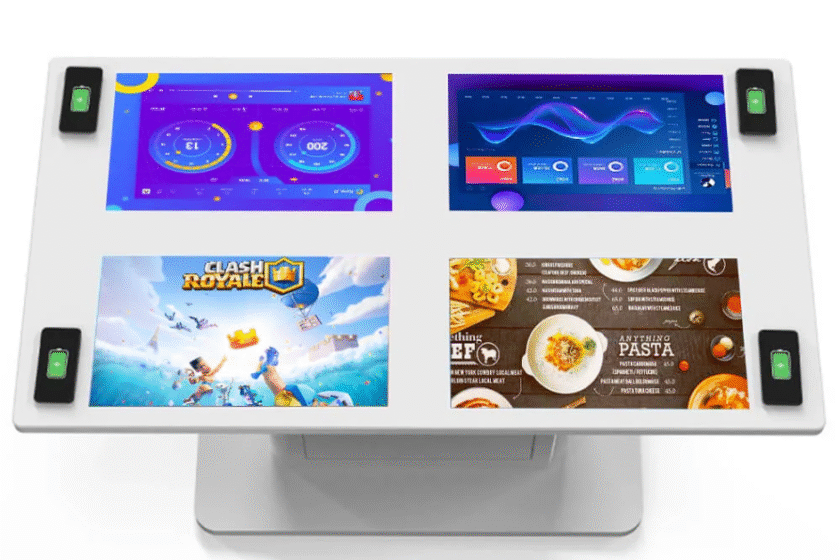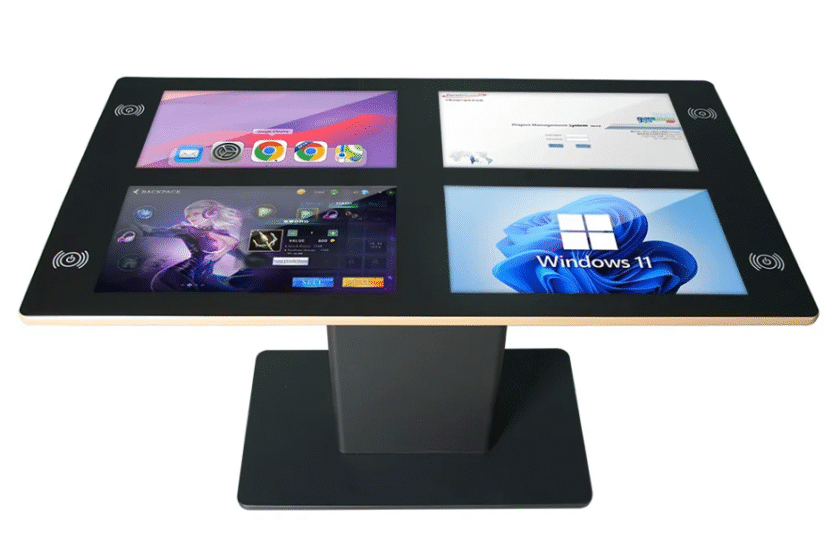Is the Circular Touch Table Interactive the Future of Digital Signage Engagement?
The landscape of digital signage is constantly evolving, moving beyond simple static screens to embrace truly interactive and immersive experiences. Among the most innovative solutions capturing the attention of retailers, museums, corporate spaces, and public venues is the circular touch table interactive. This unique form factor, combining the novelty of a circular display with the power of multi-touch technology, is rapidly redefining what is possible in user engagement and information delivery within the digital realm. It’s not just a screen; it’s a shared, collaborative digital canvas designed to draw users in from every angle.
The Fundamental Shift: Understanding the Circular Touch Table Interactive

Digital signage traditionally relies on rectangular displays—a shape ingrained in our viewing habits from televisions to smartphones. The introduction of the circular touch table interactive represents a significant break from this norm. Its shape inherently changes the dynamics of interaction. Unlike wall-mounted displays that face one direction, a circular table invites multiple users to gather around it simultaneously, fostering a communal, face-to-face experience.
Beyond the Rectangle: Design and Technical Excellence
The core appeal of this technology lies in its holistic design and powerful technical specifications. These tables are engineered to be robust, capable of withstanding the rigors of public use while maintaining high-fidelity display quality. Key features include:
- Omni-Directional Viewing: The 360-degree design ensures content is viewable and interactive from any position, a crucial advantage in high-traffic environments like shopping malls or exhibition halls.
- Advanced Multi-Touch Technology: Modern units support an extremely high number of touch points, often 30 or more, enabling complex, collaborative applications where several individuals can interact with the content simultaneously, utilizing gestures like pinch-to-zoom, swipe, and rotation.
- Durability and Aesthetics: Typically featuring tempered, often anti-glare glass surfaces, these tables are resistant to spills and scratches. Their unique circular footprint often serves as a central aesthetic element in its own right, adding a modern, sophisticated touch to any space.
- Integrated Processing Power: These tables are essentially self-contained computer systems, housing high-performance CPUs and GPUs capable of running demanding, media-rich applications without lag.
Transforming the User Experience: Applications in Digital Signage
The primary purpose of any digital signage installation is to communicate and engage. The circular touch table interactive excels in this, particularly when the goal is to drive longer dwell times and deeper interaction with product or service information. This is where its value shines for digital signage product users, who are constantly seeking methods to elevate the in-store or in-venue experience.
Elevating Retail and Product Discovery
In retail, the circular touch table moves beyond simple product listings to create immersive brand stories. A customer looking for a specific item can place a physical product, such as a bottle of perfume or a branded object, onto the table’s surface (a concept known as object recognition), triggering a 360-degree interactive display of its features, components, and lifestyle applications.
Example Application: A high-end automotive dealership might use the table to allow multiple family members to simultaneously customize a car model, changing paint colors, interior fabrics, and wheel styles in real-time. This collective decision-making process is facilitated seamlessly by the circular format, significantly enhancing the buying experience.
Collaborative Planning in Corporate and Educational Spaces
While often categorized under digital signage, the use of the circular touch table interactive extends powerfully into corporate and educational settings. It serves as an unparalleled collaboration tool. During a brainstorming session, team members can gather around, annotating documents, manipulating 3D models, or organizing data sets simultaneously. This shifts the focus from a presentation led by one person to a truly democratic, shared exploration of information.
Immersive Storytelling in Museums and Exhibitions
Museums and cultural institutions benefit immensely from the novelty and functionality of this technology. Historical maps, intricate archaeological finds, or complex scientific models can be presented in a way that encourages group learning. Visitors can zoom in on details, read multilingual descriptions, and trigger related video content, all without obstructing the view or access of others standing nearby. This interactive, non-linear approach to information delivery provides a much richer and more memorable visitor journey than traditional placards or linear documentaries.
Strategic Advantage: Why Circularity Matters for Engagement

The circular form factor is not merely a stylistic choice; it possesses psychological and practical advantages that translate directly into enhanced engagement metrics.
Fostering Natural Social Interaction
Humans naturally convene around circular or round objects, whether it’s a campfire or a dining table. The circular touch table utilizes this instinct, encouraging users to face each other while they interact with the content. This promotes discussion and shared discovery—a crucial differentiator from linear digital kiosks. For a brand, this means the table becomes a communal hub, transforming a solitary digital interaction into a social, shared brand moment.
Optimizing Spatial Flow
From a spatial design perspective, a round display facilitates better foot traffic flow in crowded spaces. There are no sharp corners to navigate around, and the non-directional nature means it can be placed centrally without favoring one side of the room over another. This maximizes its visibility and accessibility, which are key considerations for effective digital signage deployment.
Content Adaptation and Design
A significant technical hurdle is designing content specifically for the circular format. Standard rectangular content must be thoughtfully adapted to utilize the entire surface area and accommodate the multi-user, omni-directional viewpoint. Applications need to be robustly designed with multi-threading capabilities to handle numerous simultaneous inputs without performance degradation. Furthermore, the content should be easily updateable via a centralized Content Management System (CMS), ensuring the digital signage remains current and relevant.
Data-Driven Insights
One of the most valuable aspects of interactive digital signage is the data it generates. The circular touch table interactive can track user behaviors, including the most frequently accessed content, the average interaction time, and even popular gestures. This data offers unprecedented insights into user preferences and content effectiveness, allowing digital signage users to continually refine their marketing and communication strategies for greater impact.
The Ethical and Value Proposition
The use of advanced technology in public spaces carries a responsibility. The circular touch table interactive should be deployed with a clear focus on providing genuine user value. Its role must be to inform, educate, and entertain, not merely to bombard users with aggressive advertising. The best applications are those that use the shared, interactive nature to simplify complex information or create a memorable, positive brand association. This responsible, value-driven approach is essential for maintaining a positive brand image and ensuring the longevity of the installation’s appeal. This technology promotes positive interaction, standing in stark contrast to personal mobile devices which often isolate users.
Conclusion: A New Era of Shared Digital Experiences
The circular touch table interactive is a powerful indicator of the direction in which digital signage is heading: towards shared, deeply engaging, and highly visual communication platforms. For product users in the digital signage space, this technology offers a unique opportunity to stand out from the crowd, maximize spatial efficiency, and garner valuable user data. Its ability to turn a simple viewing experience into a collaborative event makes a strong case for its designation not just as a niche product, but as a potential centerpiece for future public and commercial digital environments. While it demands specialized content and a thoughtful approach to integration, the high return on engagement makes it a compelling investment for those committed to the forefront of digital experience design.
Frequently Asked Questions (FAQ)
Q1: What is the main benefit of a circular touch table interactive compared to a standard rectangular touch screen?
A: The main benefit is its omni-directional engagement and collaborative design. A circular table inherently encourages multiple users to gather around and interact simultaneously, facing each other rather than a wall. This fosters shared discovery and discussion, leading to longer dwell times and a richer, more social user experience than a standard, linear rectangular screen.
Q2: Is content development for a circular display more difficult?
A: Yes, content development requires specialized attention. Standard rectangular content must be redesigned to properly utilize the 360-degree canvas and consider the multiple viewpoints. Applications must be optimized for multi-touch inputs and complex, simultaneous interactions to ensure a seamless user experience.
Q3: Where are circular touch table interactives most effectively used?
A: They are most effective in high-traffic, communal areas where shared interaction is desired. This includes retail environments (for product customization and brand storytelling), museums (for collaborative learning and immersive historical displays), and corporate lobbies or meeting rooms (for dynamic brainstorming and data visualization).
Q4: How does a circular touch table benefit digital signage SEO?
A: While the table itself doesn’t directly affect website SEO, the novelty and high engagement of the circular touch table interactive often lead to higher foot traffic, organic social media mentions, and media coverage of the venue. This indirect brand visibility and authority can positively impact overall online search performance.



